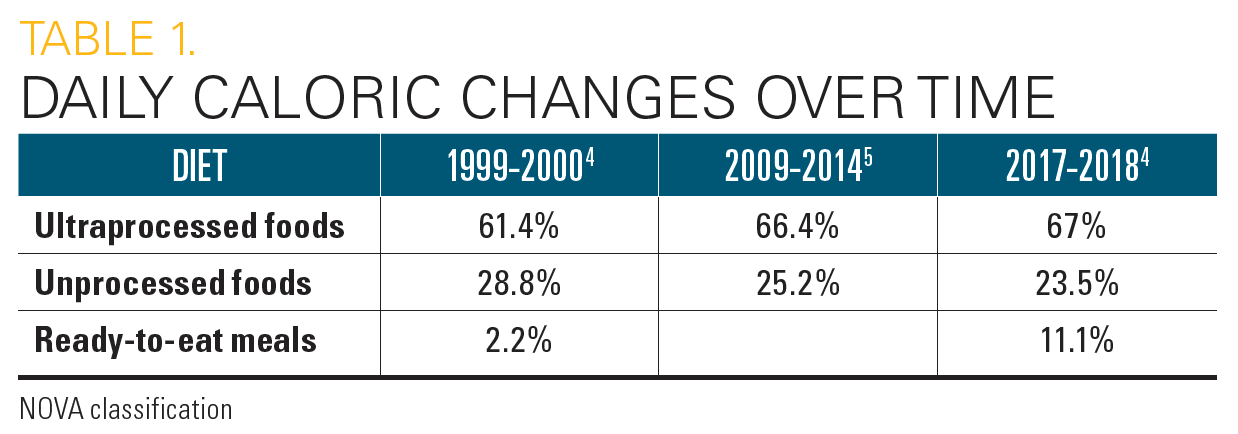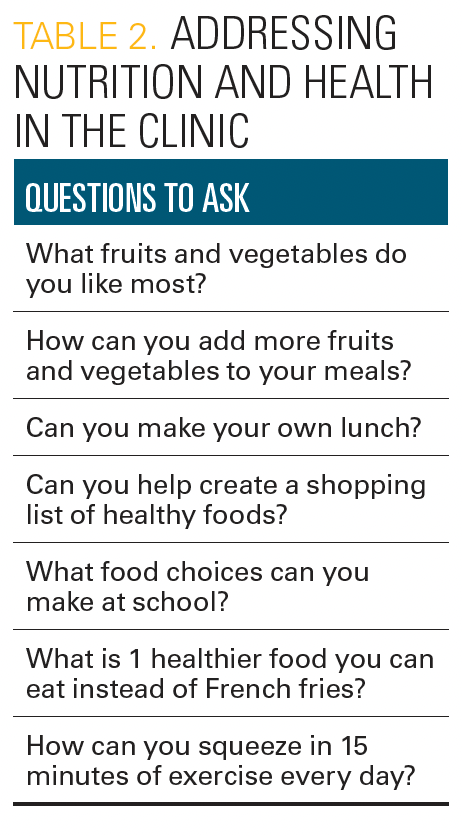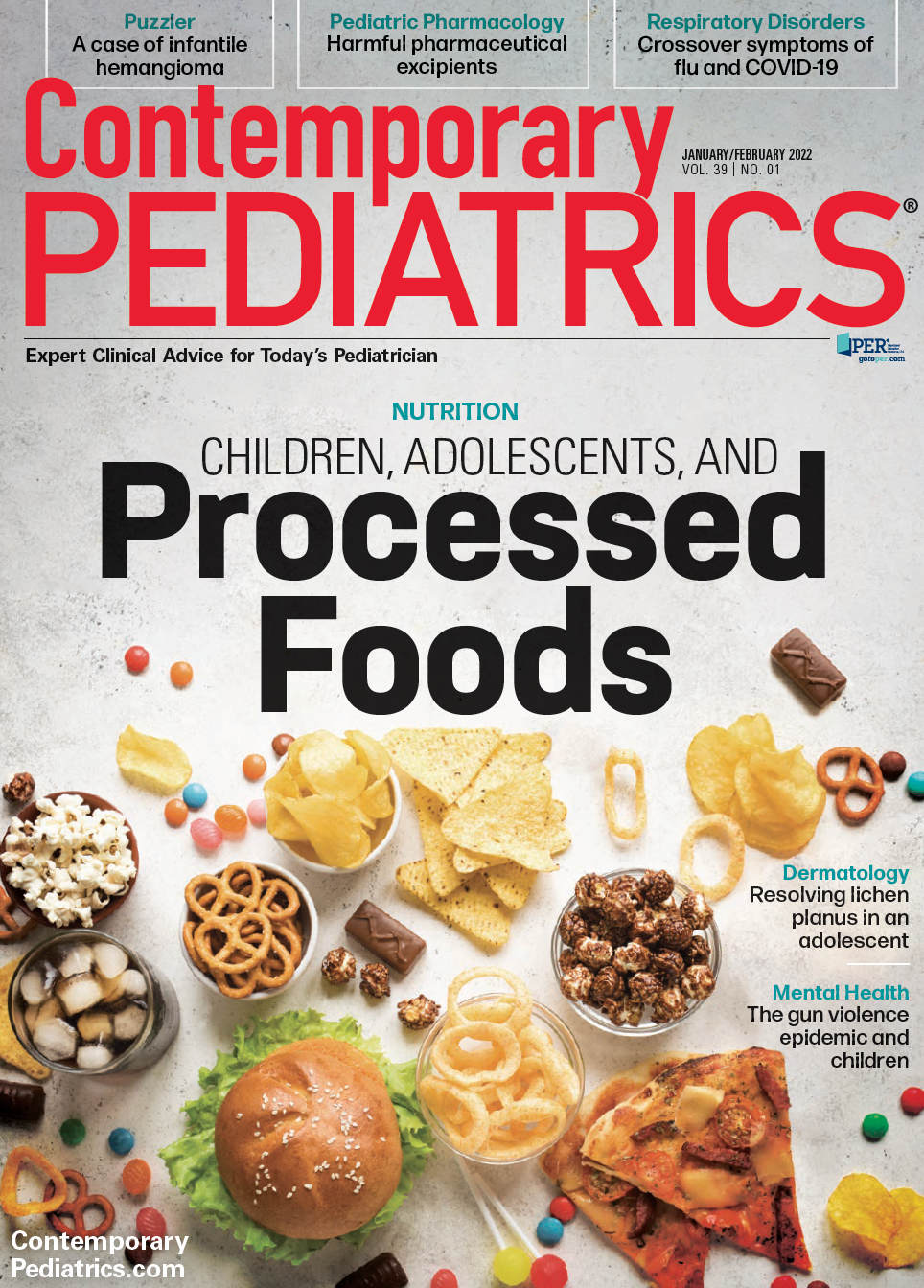Eating habits of children during COVID-19
Disruptions to routines and economic troubles have affected the diets of families. Here’s how to foster better nutrition.
Obesity has increased in many segments of the population over recent decades, including children and adolescents. The COVID-19 pandemic has accelerated that trend, bringing to light changing patterns in eating habits, disparities in access to healthy food, decreased activity, and increased risk of poor health outcomes.
Historically, food was transformed for improved palatability, as well as preservation and storage.1 Foods have been processed to make them more appealing for both convenience and taste. Since the 1970s, ultraprocessed foods have been available in most of the world and over the past 20 years have become a major source of calories, comprising an average of 3 out of 5 calories consumed daily2-4 (Table 14,5). Ultraprocessed foods are easy to manufacture, which reduces industrial costs for companies.6 Food corporations have focused on advertising and marketing of these products to improve sales, but eating more ultraprocessed foods leads to a decline in dietary content of important vitamins, minerals, protein, and fiber.6,7
Table 1

Increased consumption of ultraprocessed foods has paralleled an increase in obesity, now involving low- and middle-income countries as well, contributing to a global health crisis.8,9 Children are an especially vulnerable population because they have higher nutritional needs for healthy growth, and critical nutrients are often absent from a diet of mostly ultraprocessed foods.8 The number of ready-to-eat meals consumed has significantly increased as well in the United States (Table 1).4 Adequate nutrition is necessary to support the immune system and prevent infection.10 Eating a diet low in nutritional value increases risk of malnutrition and rates of chronic diseases.8
The NOVA classification system, developed by investigators at the University of Sao Paulo in Brazil, separates food into 4 categories based on their constitution and alteration. Foods with significant processing classically have been viewed as detrimental to overall health with promotion of weight gain and risk of chronic disease; however, there has been some discussion of the pitfalls that come with the classification system.1 Some foods are processed to add nutrients, such as iron-fortified cereal.6 Processing also may be important to ensure the safety of foods consumed.4
Nevertheless, ultraprocessed foods are generally of low nutritional quality with high-energy density and are associated with the development of chronic noncommunicable diseases with long-term effects on health. Consumption of ultraprocessed foods is associated with a high glycemic response and reduced satiety, which may contribute to overeating.4 Noncommunicable chronic diseases, including cardiovascular disease and metabolic syndrome, account for 70% of deaths worldwide.11
The NOVA classifications
UNPROCESSED FOODS: foods consumed whole without major alterations or changes. These include fresh or frozen fruits, vegetables, meats, or legumes with minimal processing. The food itself is not changed and is considered a whole food.2,6
PROCESSED CULINARY INGREDIENTS: food items used in cooking to add flavor and taste or that are part of unprocessed foods. These include table salt, sugar, oil, and other substances extracted from unprocessed foods.2,6
PROCESSED FOODS: foods taken from nature and altered with added substances, often sugar or salt, to create more stable and appealing foods. This includes canned fruits and vegetables, simple breads, and cheeses.2,6
ULTRAPROCESSED FOODS: foods with a combination of several ingredients creating a packaged food or meal that is sustainable, convenient, and appetizing. In addition to added culinary ingredients (sugar, salt, and oils), ultraprocessed foods also include nonculinary products such as high fructose corn syrup and artificial sweeteners.2 Added sugars, saturated fats, emulsifiers, and preservatives can extend the shelf life for months to years.6 Added sugars include brown sugar, cane sugar, confectioner’s sugar, granulated sugar, syrups, and honey. These foods tend to promote inflammation.10 The 2015-2020 Dietary Guidelines for Americans recommended limited intake of added sugars with a goal that sugars be less than 10% of total calories consumed.2,8
Adolescent eating habits
Recent research into the dietary habits of adolescents around the world has focused on exposure to ultraprocessed foods. The National Health and Nutrition Examination Survey reviewed 10 cycles of 24-hour dietary recall to understand what children and adolescents were eating daily. They reviewed 2 different time periods, 1999-2000 and 2017-2018 to look at dietary eating habits.4 They found that consumption of ultraprocessed foods increased as children got older, with the highest percentages of daily intake occurring in adolescents.8
Adolescence is a crucial time for emotional, mental, and physical development as individuals gain autonomy and independence. Several factors influence eating habits of adolescents, including their physical surroundings and social environment, self-awareness of food preferences and nutritional needs, and their exposure to the digital world of social media and advertisements.12 Adolescents believe the definition of healthy includes a balanced diet, consistent physical activity, and maintenance of a healthy body weight, but they sometimes struggle with how to characterize energy-dense and processed food.12 Food marketing targeted at children and adolescents through television and social media has been linked with a preference for those ultraprocessed foods that tend to be unhealthy.7 In 2009, $1.8 billion was spent on marketing to adolescents of ultraprocessed foods such as sugary carbonated beverages, snack foods, cookies, potato chips, and cakes.7
The World Health Organization has recommended reducing advertisements targeted toward children and developing a nutritional criterion for advertising.7 Governing bodies have encouraged a reduction of targeted marking of ultraprocessed foods to children and adolescents. The Better Business Bureau’s voluntary Child Food and Beverage Initiative in 2006 promoted reduced marketing. Seventeen large corporations agreed to advertise only healthy foods to children but in the end only a few companies actually reduced their marketing.7
Other governing policy changes such as a soda tax has led to a decreased consumption of soft drinks.4 The National Student Lunch Program has been modified to reduce total calories and to increase fruits and vegetables. These changes have led to a slight decrease in ultraprocessed foods available at schools, however there is still a lot left to do to improve the health of children and adolescents.4,13
COVID-19 pandemic
The COVID-19 pandemic disrupted dietary habits with the transition from work and school to home for many families. The pandemic heightened the consumption of ultraprocessed foods as schools closed and access to food changed.10 In the early months of the pandemic, more meals were cooked and prepared at home to allow for social distancing and infrequent trips to restaurants and stores. However, this also meant that foods with longer shelf lives and sustainability, such as high-calorie snacks and nonperishable goods, were purchased more often.14 With the economic burden of the pandemic, families attempted to cope with food insecurity by purchasing foods with long shelf lives and low cost to ensure there would be food in the house.13
The environment in which food was consumed in the home also has been altered during the pandemic. Adolescents reported eating more snacks rather than daily structured meals, and a study of 24-hour diet recall in several countries found increased intake of ultraprocessed foods during the COVID-19 pandemic’s first year.15,16 Additionally, sleeping patterns were disrupted, and there was an increase in screen time for both school and leisure, especially in low-income families.16 Given these extra stressors and isolation, adolescents reported an increase in “comfort food” consumption, which also contributed to excess weight gain.10
Increased weight gain associated with the pandemic has been documented around the world.10 Previously, weight gain trends were known to occur during summer months when children did not have a regular school schedule with structured physical activity and all meals were consumed at home. During the COVID-19 pandemic, similar trends were seen with weight gain when many children were no longer regularly attending school. A disproportionate burden was seen among low-income households.13
The COVID-19 pandemic not only exacerbated racial and ethnic disparities present in the United States with higher rates of COVID-19 infection and severe outcomes in Hispanic and non-Hispanic Black children, but it also disproportionally affected food access in these communities.17 Previously, the National School Health Program benefited children of low-income households, allowing access to predictable meals throughout the week. There were attempts to expand the summer lunch program during the COVID-19 pandemic to provide food to families, however, due to a lack of resources, the efforts proved difficult to implement.13
Food deserts and food insecurity
Food deserts are areas in low-income neighborhoods with limited food resources, particularly for healthy and fresh foods such as fruits, vegetables, and whole grains. There is a larger presence of fast-food restaurants and convenience stores offering predominantly ultraprocessed foods.13 Food insecurity is defined as limited or uncertain access to food that is nutritionally adequate due to lack of money or ways to acquire food.14 Households with less financial stability and fewer resources often are those with higher rates of obesity.13 Children living in poverty also are experiencing higher rates of infection and severe disease during the COVID-19 pandemic.17
During the COVID-19 pandemic, food insecurity increased and families purchased ultraprocessed foods more often due to lower cost and the foods’ longer shelf life.14 Decisions about the most cost-effective methods to provide food were influenced by lower costs for higher-calorie foods.13 During lockdown with social distancing, acquiring foods became even more difficult for families with food insecurity, and most families experienced a further reduction in income, only exacerbating the problem.14 Food insecurity rates in families tripled 6 weeks after the lockdown and overall food insecurity rates increased by approximately 20% in the United States and contributed to poor quality of diet.13,14 Children are often aware of their family’s food insecurity despite parental attempts to shelter them of that fact.13
Long-term solutions
For clinicians, engaging with both parents and adolescents during visits creates an environment of shared decision-making, and motivational interviewing can lead to the most success for implementing dietary changes. Potential engaging questions that lead to action are included in Table 2. Utilizing a multidisciplinary approach, including access to behavioral psychologists and dietitians to help with decision-making and meal planning, also can be helpful.
Table 2

Screening for social determinants of health with a focus on food security is becoming a common practice in pediatrician offices due to the frequency of visits, even if they are virtual. Whereas education is important, it alone does not have the desired impact on food insecurity. Recognition of social stressors associated with poverty is important due to its disruption of development and contribution to chronic disease. Addressing the “hunger vital sign” to screen for food insecurity can be done at all visits, both in person and virtual.13 Normalization and recognition of the struggle that families face, especially during the COVID-19 pandemic, can help families be more willing to discuss options for assistance.13 Primary care providers should be prepared to discuss social determinants of health in addition to having knowledge about weight concerns and obesity. Providing resources to families and ensuring adequate follow-up are crucial to promote long-term health.14 Active and passive referrals for food resources can be done by providing information for food shelters or giving foods directly to families at the visit.13
References
1. Petrus RR, do Amaral Sobral PJ, Tadini CC, Gonçalves CB. The NOVA classification system: a critical perspective in food science. Trends Food Sci Technol. 2021;116(3):603-608. doi:10.1016/j.tifs.2021.08.010
2. Martínez Steele E, Baraldi LG, da Costa Louzada ML, Moubarac JC, Mozaffarian D, Monteiro CA. Ultra-processed foods and added sugars in the US diet: evidence from a nationally representative cross-sectional study. BMJ Open. 2016;6(3):e009892. doi:10.1136/bmjopen-2015-009892
3. Baker P, Machado P, Santos T, et al. Ultra‐processed foods and the nutrition transition: global, regional and national trends, food systems transformations and political economy drivers. Obes Rev. 2020;21(12):e13126. doi:10.1111/obr.13126
4. Wang L, Martínez Steele E, Du M, et al. Trends in consumption of ultraprocessed foods among US youths aged 2-19 years, 1999-2018. JAMA. 2021;326(6):519-530. doi:10.1001/jama.2021.10238
5. Martínez Steele E, Popkin BM, Swinburn B, Monteiro CA. The share of ultra-processed foods and the overall nutritional quality of diets in the US: evidence from a nationally representative cross-sectional study. PopulHealth Metr. 2017;15(1):6. doi:10.1186/s12963-017-0119-3
6. Dunford EK, Ng SW, Taillie LS. How does the healthfulness of the US food supply compare to international guidelines for marketing to children and adolescents? Matern Child Health J. 2019;23(6):768-776. doi:10.1007/s10995-018-02693-1
7. Chang K, Khandpur N, Neri D, et al. Association between childhood consumption of ultraprocessed food and adiposity trajectories in the Avon Longitudinal Study of parents and children birth cohort. JAMA Pediatr. 2021;175(9):e211573. doi:10.1001/jamapediatrics.2021.1573
8. Calcaterra V, Vandoni M, Pellino VC, Cena H. Special attention to diet and physical activity in children and adolescents with obesity during the coronavirus disease-2019 pandemic. Front Pediatr. 2020;8:407. doi:10.3389/fped.2020.00407
9. Neri D, Martinez‐Steele E, Monteiro CA, Levy RB. Consumption of ultra‐processed foods and its association with added sugar content in the diets of US children, NHANES 2009‐2014. Pediatr Obes. 2019;14(12):e12563. doi:10.1111/ijpo.12563
10. Lane MM, Davis JA, Beattie S, et al. Ultraprocessed food and chronic noncommunicable diseases: a systematic review and meta‐analysis of 43 observational studies. ObesRev. 2021;22(3):e13146. doi:10.1111/obr.13146
11. Barco Leme AC, Fisberg RM, Baranowski T, et al. Perceptions about health, nutrition knowledge, and MyPlate food categorization among US adolescents: a qualitative study. J Nutr Educ Behav. 2021;53(2):110-119. doi:10.1016/j.jneb.2020.11.008
12. Dunford EK, Ng SW, Taillie LS. How does the healthfulness of the US food supply compare to international guidelines for marketing to children and adolescents? Matern Child Health J. 2019;23(6):768-776. doi:10.1007/s10995-018-02693-1
13. Tester JM, Rosas LG, Leung CW. Food insecurity and pediatric obesity: a double whammy in the era of COVID-19. Curr Obes Rep. 2020;9(4):442-450. doi:10.1007/s13679-020-00413-x
14. Adams EL, Caccavale LJ, Smith D, Bean MK. Food insecurity, the home food environment, and parent feeding practices in the era of Covid‐19. Obesity. 2020;28(11):2056-2063. doi:10.1002/oby.22996
15. Lange SJ, Kompaniyets L, Freedman DS, et al. Longitudinal trends in body mass index before and during the COVID-19 pandemic among persons aged 2-19 years -United States, 2018-2020. MMWR Morb Mortal Wkly Rep. 2021;70(37):1278-1283. doi:10.15585/mmwr.mm7037a3
16. Teixeira MT, Vitorino RS, da Silva JH, Raposo LM, de Aquino LA, Ribas SA. Eating habits of children and adolescents during the COVID‐19 pandemic: the impact of social isolation. J Hum Nutr Diet. 2021;34(4):670-678. doi:10.1111/jhn.12901
17. White A, Liburd LC, Coronado F. Addressing racial and ethnic disparities in COVID-19 among school-aged children: are we doing enough? Prev Chronic Dis. 2021;18:E55. doi:10.5888/pcd18.210084
